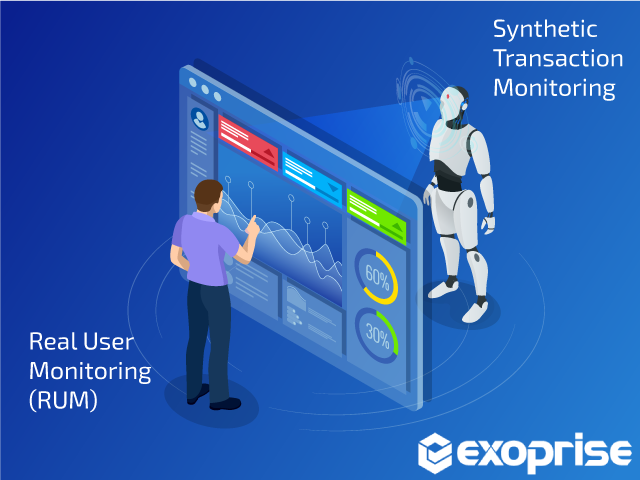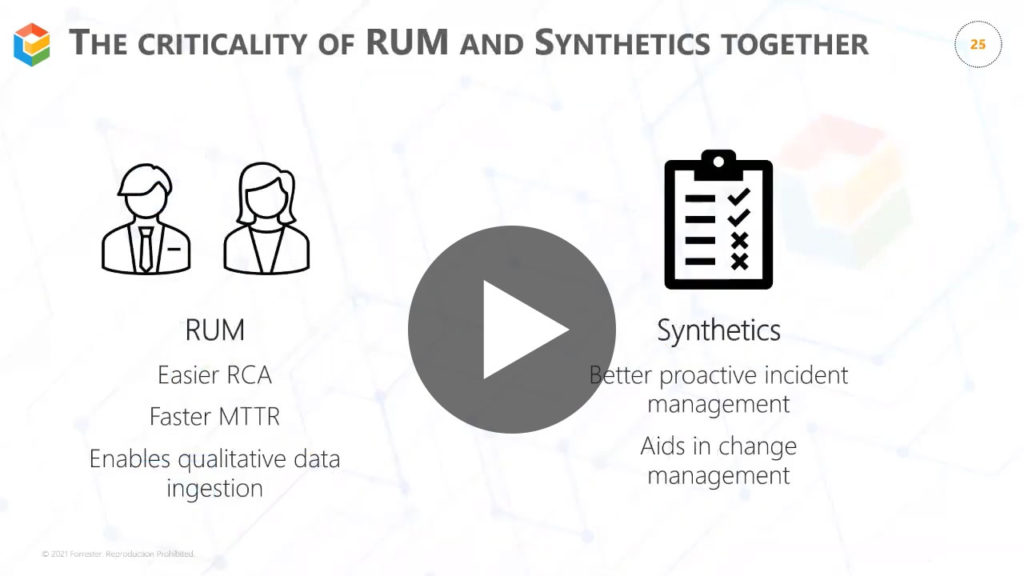With every webpage loaded, email sent, or video streamed, network traffic takes a complex journey…
Introduction
Microsoft had a stellar quarter in Q3 of this year (2020) beating expectations in all its three core segments. And the demand for its Azure cloud services continues to grow. The other heavy tech giants such as Google and Amazon also reported gains, thanks to an increase in stimulus e-commerce spending and work from home extension policies! But as several companies follow the lead of Microsoft and Google, IT leaders will need to quickly adapt to a new normal and adjust strategies to accommodate its distributed workforce. So, let’s learn why would real user monitoring matter to IT.

7 Reasons Why You Need Real User Monitoring (RUM)
Capture Beyond Synthetic Monitoring
Pre Covid, it was easier to capture end-user performance metrics for SaaS services using synthetic sensors when employees were working at the office. But after Covid struck, circumstances changed. Employees are now working in a different home setting (LAN, WAN, VPN) where one expects varying degrees of internet connection, Wi-Fi, application, and network monitoring issues. Earlier, IT would receive tickets in ServiceNow where fixing one ticket would immediately remediate technical issues across the entire organization.
However, in present times, IT teams are getting inundated with tickets that represent individual home settings and a challenging troubleshooting process. There is no visibility into end-user experience metrics and additional time is being spent trying to resolve issues. When more tickets get created in ITSM, it becomes burdensome for any team to manage and successfully close them.
No one knows where the fault really lies, and war rooms escalate. RUM makes it possible to collect applications and network monitoring performance data from the browser and individual machines. IT can employ the crowdsourcing model along with Digital Experience Monitoring (DEM) solutions to quickly determine if it is an end-user or corporate-wide issue.
Putting Customers First
Gone are the days when companies built a product, but its information on a website, and assumed customers would buy from them. This product-centric model has now shifted to becoming a customer-oriented model. Engineers, UI experts, and customer success teams now work backward to understand all the hops in the buying journey that would make a customer happy.
As part of this journey are changing variables that can impact the end-user experience of the website such as slow page load and server response time, high latency, traffic bottlenecks, product cart page timeout, DNS delays, etc.
By combining synthetics and real user data, IT can monitor in real-time how well the newly developed SaaS applications are performing and execute root cause analysis faster. This SaaS visibility can help designers and developers build pages that can streamline the end-user experience.
At a macro level, collecting application and network monitoring usage metrics of the website user experience from a wider audience can determine the success and future of the newly released SaaS product.

Microsoft Teams Productivity and Collaboration
Remote work is here to stay, and regular citizens continue to adapt to working from home. Consequently, millennials are moving out to the suburbs in search of a better cost of living. Application usage of productivity tools such as Microsoft Teams, Office 365, Salesforce, Zoom, etc. continues to rise.
If employees continue to receive poor experience on these applications, productivity suffers, and business gets impacted. RUM can provide critical insights on end-user response time for mission-critical applications like Teams and help IT remediate performance issues.
Crowdsourcing data can reveal if the issue is local or across the board. The less time IT spends on investigating and resolving tickets, the faster can employees and customers be happy.
Companies meet their SLA and employees become proactive and productive.
SaaS Application and Network Transparency
Just because Office 365 is up and running, does not necessarily mean that it is performing optimally. Enterprise applications of today run from the cloud in a microservices architecture abstracting complexity between the frontend, middleware, and backend. Instrumentation of these applications via legacy tools for collecting cloud performance metrics is not possible.
End-users utilize applications in several different ways for respective workflow and functionality needs.
Moreover, certain users prefer running their applications on specific browsers and devices. Application performance monitoring (APM) use cases have become different and personalized and therefore, monitoring needs to incorporate all scenarios.
With different combinations and the path to success involved, IT needs RUM to understand Office 365 application transactions that touch different endpoints (modules, systems, and devices) and the underlying Azure infrastructure that supports the application.
Move to Mobile
Statista projects that the number of mobile users worldwide will reach 7.41 billion up from 6.95 billion in 2020.
Mobiles have already penetrated our daily life as PC sales decline. Within our professional lives too, mobiles have found their place to conduct business transactions via apps. Exchange online, outlook, Office 365, and Salesforce are some of the examples.
Mobile app synthetic monitoring exists today. However, continually assessing the impact of BYOD on digital strategy via RUM and how mobile users can gain the same experience as PC users become critical as mobile adoption increases.
Automated 360-degree View into Digital Experience
RUM can detect and monitor the end-user SaaS experience whether working from HQ behind a firewall or connected directly to the cloud from home.
Understanding page views and load performance, browser usage, etc. for mission-critical business applications across all the locations is key for evaluating the normalcy of the new work setup we all are living in today. Gaining automated insights with a 360-degree view for passive monitoring is a reliable strategy to accurately detect issues and fix them quickly.
Slow is The New Down
Uptime is an important metric that SaaS companies originally relied on. But today, downtime is equally significant considering that IT is responsible for 24/7 performance and reliability. If your Microsoft Teams application is slow or degrading in performance before that next important call, it can result in loss of business deals and poor experience to clients.
Additionally, a new DevOps cloud migration change introduced in the production environment can introduce new bottlenecks and impact the customer buying decision.
Nevertheless, IT should be able to proactively manage downtime if only they can measure downtime. End-user application monitoring becomes critical to the company’s success and needs to be integrated into IT strategy.
Free Real User Monitoring Tool for End-User Digital Experience
Exoprise Service Watch Desktop introduced in September of this year provides the best real user monitoring for SaaS and cloud apps.
Combined with synthetic user monitoring, RUM extends into the end-user digital experience by monitoring browsers, devices, endpoints, and collecting advanced telemetry machine performance data. Associate your digital brand with agility, speed, and not slowness. See why RUM and Synthetic monitoring matter from the video below.
Monitor real-user behavior and assess areas to optimize with Service Watch Desktop. Detect, identify, and troubleshoot application and network performance issues in real-time with a modern monitoring tool.
Gartner recently recognized the Exoprise Application Performance Monitoring tool as a leading solution for monitoring Office 365, managing SaaS end-user experience, and pinpointing performance monitoring issues.
Learn more about Exoprise end-user experience monitoring solution and get a free 15-day trial.



